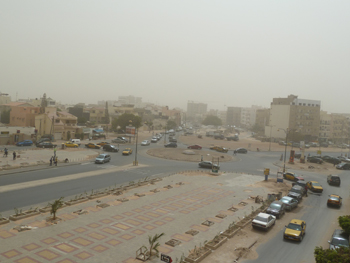
The capital city Dakar sticks out into the Atlantic like a small thumb on the fist that is Senegal. Though it's February, outside my hotel stands a fake Christmas tree, at least eight feet high, covered in a thick layer of dust--or, more accurately, sand. The West African trade wind is blowing south from Mauritania and bringing the Sahara desert with it. It's a winter weather phenomenon called the "Harmattan," and it's kicking up the worst sand haze in years. Today the air is so thick with fine sand that's blown nearly a thousand miles from the Sahara, it's hard to breathe.
The steady advance of the desert is a serious problem in Africa's Sahel region. This dry grassland forms the boundary between the Sahara to the north and the equatorial jungles to the south. A drier climate and the creeping desert make it increasingly difficult for farmers to grow crops. Food insecurity and hunger have become a way of life, so Sahel countries are pinning their hopes on the Great Green Wall.
The Great Green Wall will be a 5,000 mile wall of trees, nine miles wide, stretching from Senegal to Djibouti. It's intended as a physical barrier to block the steady advance of the Sahara desert, but its success depends on the cooperation of the 11 nations along its path. And communities that have agreed to plant the trees need to nurture them.
After Dakar, I'm visiting communities that have already planted trees for the Great Green Wall. I have many questions: How do they keep trees alive in this harsh environment? How have people's lives changed as a result? Do they believe in this endeavor--and can it work? For the people whose homes lie in this harsh but fragile environment, those questions are a matter of life and death.



